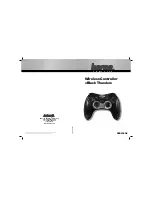
5-414
L90 LINE CURRENT DIFFERENTIAL SYSTEM – INSTRUCTION MANUAL
INPUTS/OUTPUTS
CHAPTER 5: SETTINGS
5
A contact inputs and outputs are digital signals associated with connections to hard-wired contacts. Wet and dry contacts
are supported.
The contact inputs menu contains configuration settings for each contact input as well as voltage thresholds for each
group of four contact inputs. Upon startup, the relay processor determines (from an assessment of the installed modules)
which contact inputs are available and then display settings for only those inputs.
An alphanumeric ID can be assigned to a contact input for diagnostic, setting, and event recording purposes. The
CONTACT IP
X On
(Logic 1) FlexLogic operand corresponds to contact input “X” being closed, while
CONTACT IP X Off
corresponds to contact
input “X” being open. The
CONTACT INPUT DEBNCE TIME
defines the time required for the contact to overcome ‘contact
bouncing’ conditions. As this time differs for different contact types and manufacturers, set it as a maximum contact
debounce time (per manufacturer specifications) plus some margin to ensure proper operation. If
CONTACT INPUT EVENTS
is
set to “Enabled,” every change in the contact input state triggers an event.
A raw status is scanned for all Contact Inputs synchronously at the constant rate of 0.5 ms as shown in the following
figure. The DC input voltage is compared to a user-settable threshold. A new contact input state must be maintained for a
user-settable debounce time in order for the L90 to validate the new contact state. In the following figure, the debounce
time is set at 2.5 ms; thus the 6th sample in a row validates the change of state (mark no. 1 in the diagram). Once validated
(de-bounced), the contact input asserts a corresponding FlexLogic operand and logs an event as per user setting.
A time stamp of the first sample in the sequence that validates the new state is used when logging the change of the
contact input into the Event Recorder (mark no. 2 in the figure).
Protection and control elements, as well as FlexLogic equations and timers, are executed eight times in a power system
cycle. The protection pass duration is controlled by the frequency tracking mechanism. The FlexLogic operand reflecting
the debounced state of the contact is updated at the protection pass following the validation (marks no. 3 and 4 on the
figure that follows). The update is performed at the beginning of the protection pass so all protection and control functions,
as well as FlexLogic equations, are fed with the updated states of the contact inputs.
The FlexLogic operand response time to the contact input change is equal to the debounce time setting plus up to one
protection pass (variable and depending on system frequency if frequency tracking enabled). If the change of state occurs
just after a protection pass, the recognition is delayed until the subsequent protection pass; that is, by the entire duration
of the protection pass. If the change occurs just prior to a protection pass, the state is recognized immediately. Statistically
a delay of half the protection pass is expected. Owing to the 0.5 ms scan rate, the time resolution for the input contact is
below 1 ms.
For example, eight protection passes per cycle on a 60 Hz system correspond to a protection pass every 2.1 ms. With a
contact debounce time setting of 3.0 ms, the FlexLogic operand-assert time limits are: 3.0 + 0.0 = 3.0 ms and 3.0 + 2.1 = 5.1
ms. These time limits depend on how soon the protection pass runs after the debouncing time.
Regardless of the contact debounce time setting, the contact input event is time-stamped with a 1
μ
s accuracy using the
time of the first scan corresponding to the new state (mark no. 2 shown). Therefore, the time stamp reflects a change in the
DC voltage across the contact input terminals that was not accidental as it was subsequently validated using the
debounce timer. Keep in mind that the associated FlexLogic operand is asserted/de-asserted later, after validating the
change.
The debounce algorithm is symmetrical: the same procedure and debounce time are used to filter the LOW-HIGH (marks
no.1, 2, 3, and 4 in the figure) and HIGH-LOW (marks no. 5, 6, 7, and 8) transitions.
Ips H5a,H5c,H6a,H6c
THRESHOLD: 33 Vdc
Range: 17, 33, 84, 166 Vdc
Ips H7a,H7c,H8a,H8c
THRESHOLD: 33 Vdc
Range: 17, 33, 84, 166 Vdc
↓
Ips xxx,xxx,xxx,xxx
THRESHOLD: 33 Vdc
Range: 17, 33, 84, 166 Vdc
















































